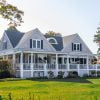We’ve all heard the saying, “Location, location, location!” It’s the old adage that has been passed down for many decades, speaking to real estate values and wise investing. Over the years, I’ve found it interesting that “location” can mean so much more than a zip code, and based on lifestyle trends and community changes, perception of desirable locations can change with time.

For a local example of change, think about the west side of Danville. If we go back in time, we’ll find small, simple houses built by the railroad tracks, that wouldn’t have excited too many buyers. Those who could afford to would drive farther up the hills or away from town, to build or purchase homes in the best locations. A homesite that offered views, privacy and distance from town was considered a premium location. Many home buyers and homeowners today still value those features. However, by the mid-1970’s, plans were underway to remove the railroad tracks and convert the space to a regional trail that would become part of East Bay Regional Parks. Suddenly, the homes with possibly the worst location, were going to become far more desirable. Fast forward a few more decades. Through a combination of careful planning and historic preservation, coupled with beautiful improvements to infrastructure, downtown Danville became one of the most desirable downtowns in the east bay. “Walkability” has also become one of the single most important location features for buyers in all age groups. Today, the homes that are close to the Iron Horse Trail, and especially those close to town, are some of the most desirable for buyers.
Other examples of locations that go for a premium include court locations, view locations. and streets that generally have well maintained, nicer than average homes. Walkability in any part of town, to schools, parks, shopping, swim clubs, and trails are also valuable. It’s important to note that for maximum value, most buyers prefer not to be adjacent to these destinations, just really close. It’s all subjective. One buyer may see extra value in living across the street from a school or park, while another may prefer a quieter location that affords more privacy.
If you’re considering purchasing real estate of any kind, be sure to investigate the location. Find out what the zoning is for nearby properties. You might be surprised. Are there plans to extend a road into a major thoroughfare? Does the street with all residences on it, also have zoning that allows commercial use? Who owns the beautiful golf course that is the focal part of the view – can they sell the land and change the use? There are endless other questions to consider, depending on the location.
Should location take priority over all other variables? It depends. Carefully consider what is important to you, with respect to location. Then weigh that option, against your other “needs.” If your finances allow for it, you may be able to improve or add onto a house that is in the best location. However, if you don’t have the time or resources, you are probably better off finding a home that fits the rest of your needs and your budget, in a good location, instead of the best location.
If you choose to buy property that has a major negative in the location, that’s okay too. Just make sure that you are not paying more than fair value, because when it comes time to sell, you will need to price accordingly. For plenty of buyers, it’s worth it to buy the least desirable location in a community, just to be able to afford to own in that community, versus a different one. It’s all about perspective.
Every home is unique. If the thought of evaluating your options has you feeling overwhelmed, please feel free to reach out to me at 925-964-5010 or via email at Lisa.Hopkins@Compass.com for a custom analysis of your options. Even if you’re not planning to move, I’m happy to help by providing you with relevant data, enabling you to make a well informed decision. It’s never too early to start planning for success.




